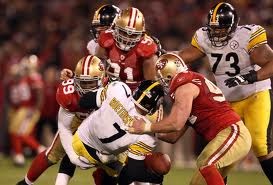- Week 5 vs. a Tampa Bay Bucs team sporting a 3-1 record, coming off 3 straight wins. Sure, Captain Hindsight will quickly state that the Bucs finished the season 4-12. However, many talking heads and media pundits had the Bucs winning this game or at least called this a 'toss-up' contest. Final score: 49ers 48, Bucs 3.
- Week 6 vs. an undefeated Detroit Lions squad coming off 5 straight wins (9 straight going back to the previous season), averaging 32 ppg over that stretch. Final score: 49ers 25, Lions 19 (in Ford Field)
- Week 10 vs. a 6-2 New York Football Giants team entering with 3 straight W's (6 of their last 7), riding the highs of an epic last drive road victory in New England (first team to defeat a Brady-led Pats team in a regular season contest in Gillette Stadium in 31 games). Final score. 49ers 27, Giants 20.
- Week 15 vs. a Pittsburgh Steelers team who seemingly had 'turned it around and were finally getting in rhythm after a slow start', on a 4 game winning streak (victories in 8 of their last 9 games). Final score: 49ers 20, Steelers 3.
- Week 16 vs. a Seattle Seahawks team riding a 3 game winning streak (5-1 over their last 6, outscoring their opponents 162-88 over that stretch; with an average margin of victory of over 16 points). This game was also played in Seattle, one of the toughest home field advantages in the entire NFL. Final score: 49ers 21, Seahawks 19.
- And then of course, last week's instant classic Divisional Playoff battle in Candlestick Park vs. a New Orleans Saints team who last suffered a defeat on October 30th (!!), putting together a 9 game winning streak outscoring their opponents by more than 17 points in each contest, installed as a 3.5 point road favorite. Final score: 49ers 36, Saints 32.
Coincidence? Luck? Even with a 14-3 record after 17 games?
On Sunday, the Giants will not be playing against a team who's "on a red hot streak of games" and "playing their best football of the season".
They'll be playing the San Francisco 49ers. The NFC's most complete football team; a 'trend' that has remained CONSISTENT since Week 1, while the football world refused to pay attention.














